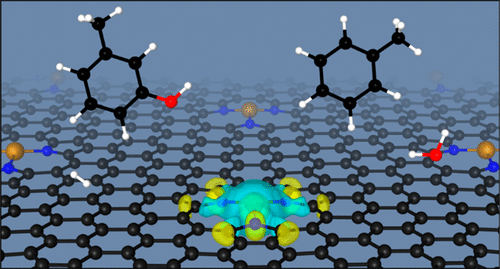当前位置:
X-MOL 学术
›
ACS Catal.
›
论文详情
Our official English website, www.x-mol.net, welcomes your
feedback! (Note: you will need to create a separate account there.)
Controlling the Oxidation State of Fe-Based Catalysts through Nitrogen Doping toward the Hydrodeoxygenation of m-Cresol
ACS Catalysis ( IF 11.3 ) Pub Date : 2020-05-18 , DOI: 10.1021/acscatal.0c00626 Yanling Yang 1 , Mingwu Tan 1 , Aidan Garcia 2 , Zhaoxia Zhang 1 , Jingdong Lin 1 , Shaolong Wan 1 , Jean-Sabin McEwen 2, 3, 4, 5, 6 , Shuai Wang 1 , Yong Wang 2
ACS Catalysis ( IF 11.3 ) Pub Date : 2020-05-18 , DOI: 10.1021/acscatal.0c00626 Yanling Yang 1 , Mingwu Tan 1 , Aidan Garcia 2 , Zhaoxia Zhang 1 , Jingdong Lin 1 , Shaolong Wan 1 , Jean-Sabin McEwen 2, 3, 4, 5, 6 , Shuai Wang 1 , Yong Wang 2
Affiliation

|
Stabilizing the oxidation state of Fe is of great importance for the rational design of Fe-based catalysts. To this end, N-doped carbon composites (NC) are prepared with different N-doping contents and used as supports for Fe particles. We find N-doped carbonaceous materials enable an effective control of the Fe oxidation state via an electronic interaction between Fe and N. This interaction leads to a decrease in the Fe particle size when the N-doping content is increased, as shown by structural characterization of transmission electron microscopy and powder X-ray diffraction, and to a weakened oxygen affinity of the Fe particles in the presence of N-doped sites, as unveiled by H2-temperature-programmed reduction measurements with separate N2O and water vapor pretreatments. The weaker oxygen affinity correlates with the excellent long-term stability of Fe/NC catalysts during the hydrodeoxygenation of lignin-derived m-cresol to form valuable aromatic products, whereas obvious oxidative deactivation is observed for Fe/C. An investigation of the surface nitrogen composition of all N-doped samples shows that their deactivation rate constants are closely related to the nitrogen content anchoring Fe into the carbon architecture, which indicates unambiguously that embedding nitrogen into the carbon skeleton (mainly including pyridinic and pyrrolic nitrogen functional groups) plays a critical role in stabilizing Fe, while amino-N is inclined to suffering from wastage during the hydrodeoxygenation reaction. These results are further confirmed computationally through an electronic analysis of Fe–N complexes embedded into graphene, showing that skeletal nitrogen sites shield Fe from oxidation relative to bare carbon or aminic nitrogen.
中文翻译:

通过氮掺杂朝的加氢脱氧控制铁基催化剂的氧化态米甲酚
稳定铁的氧化态对于铁基催化剂的合理设计非常重要。为此,制备具有不同N掺杂含量的N掺杂碳复合材料(NC),并将其用作Fe颗粒的载体。我们发现,氮掺杂的碳质材料能够通过铁和氮之间的电子相互作用有效地控制铁的氧化态。这种相互作用会导致当氮掺杂含量增加时,铁的粒径减小,如结构表征所示H 2-程序升温还原法对单独的N 2进行的测量揭示了透射电子显微镜和粉末X射线衍射的结果,以及在存在N掺杂位点时Fe颗粒的氧亲和力减弱O和水蒸气的预处理。木质素衍生的m加氢脱氧过程中,较弱的氧亲合力与Fe / NC催化剂的优异长期稳定性相关-甲酚形成有价值的芳族产物,而对于Fe / C则观察到明显的氧化失活。对所有N掺杂样品的表面氮组成的研究表明,它们的失活速率常数与将Fe固定在碳结构中的氮含量密切相关,这明确表明将氮嵌入碳骨架中(主要包括吡啶氮和吡咯氮)官能团)在稳定铁中起关键作用,而氨基N倾向于在加氢脱氧反应中遭受浪费。通过对嵌入石墨烯中的Fe–N络合物的电子分析,通过计算进一步证实了这些结果,表明相对于裸露的碳或胺态氮,骨架氮位点可保护Fe免受氧化。
更新日期:2020-07-17
中文翻译:

通过氮掺杂朝的加氢脱氧控制铁基催化剂的氧化态米甲酚
稳定铁的氧化态对于铁基催化剂的合理设计非常重要。为此,制备具有不同N掺杂含量的N掺杂碳复合材料(NC),并将其用作Fe颗粒的载体。我们发现,氮掺杂的碳质材料能够通过铁和氮之间的电子相互作用有效地控制铁的氧化态。这种相互作用会导致当氮掺杂含量增加时,铁的粒径减小,如结构表征所示H 2-程序升温还原法对单独的N 2进行的测量揭示了透射电子显微镜和粉末X射线衍射的结果,以及在存在N掺杂位点时Fe颗粒的氧亲和力减弱O和水蒸气的预处理。木质素衍生的m加氢脱氧过程中,较弱的氧亲合力与Fe / NC催化剂的优异长期稳定性相关-甲酚形成有价值的芳族产物,而对于Fe / C则观察到明显的氧化失活。对所有N掺杂样品的表面氮组成的研究表明,它们的失活速率常数与将Fe固定在碳结构中的氮含量密切相关,这明确表明将氮嵌入碳骨架中(主要包括吡啶氮和吡咯氮)官能团)在稳定铁中起关键作用,而氨基N倾向于在加氢脱氧反应中遭受浪费。通过对嵌入石墨烯中的Fe–N络合物的电子分析,通过计算进一步证实了这些结果,表明相对于裸露的碳或胺态氮,骨架氮位点可保护Fe免受氧化。











































 京公网安备 11010802027423号
京公网安备 11010802027423号